Ministry of Science and
Higher Education
of the Russian Federation
Russian Academy of Sciences
Department of power engineering, mechanical engineering, mechanics and control processes
for english » Research Departments » Department of Mechanics and Control of Machines » Historical Background
Historical Information about the Department
Machines Mechanics & Control Department is the oldest scientific subdivision of the IMASH RAN. The general theory of machines and mechanisms is one of the main directions of the work of the Mechanical Engineering Research Institute from the very beginning of its establishment. Among fathers-founders of this trend there were the leading scientists - Academicians I.I. Artobolevsky and A.A. Blagonravov. By the initiative of Academician IIArtobolevsky in IMASH in the 50s of the last century a department of the theory of machines and mechanisms was establisted. In it, the following laboratories were created: the synthesis of mechanisms (later - machines of automatic operation, dynamics and of drives control systems), machines dynamics, machines accuracy, experimental dynamics of machines. The department has solved and solves comprehensive problems in the field of development and research of machines for various purposes. In the course of its development in the department there appeared laboratories of machines of vibro-impact operation, of robotics and some others. The laboratories were headed by such prominent scientists as Academicians A.A. Blagonravov, N.G. Bruevich, Professors A.E. Kobrinsky, N.P. Rayevsky. A prosthetic sample of a hand operating under the influence of electric pulses generated by the muscles of a person has been developed at the IMASH for the 1st time in the world. The first electronic devices for studying the dynamic parameters of machines (such as displacement, speed, acceleration, pressure, etc.) were also developed at the IMASH.
Famous and Noted Scientists of the Department
Academician Ivan Ivanovich Artobolevsky (1905 - 1977)
Academician Ivan Ivanovich Artobolevsky - an outstanding researcher, mechanical engineer, a major organizer of science, a public figure. He is the developer of a new scientific and educational discipline "Theory of Mechanisms and Machines", which is the basis for the training of mechanical engineers. He is the author of fundamental textbooks on the theory of mechanisms for universities and technological institutes translated into many languages of the world, as well as more than 1000 scientific works, including a five-volume manual "Mechanisms in Modern Technology", reissued in many countries.
The initiator of the creation of the International Federation for the Theory of Machines and Mechanisms (IFToMM), numbering 45 member countries, was elected several times as its President.
I.I. Artobolevsky was Chairman of the "Knowledge"All-Union Society , a Deputy of the USSR Supreme Council and later a member of the Presidium of the USSR Supreme Soviet, Hero of Socialist Labor. Academician I.I. Artobolevsky was awarded five Orders of Lenin and three Orders of the Red Banner of Labor. The international community of scientists – mechanical engineers awarded him, the only scientist of our country, the J. Watt Gold Medal.
 Academician Ivan Artobolevsky: Materials of the Jubilee Sessions of the Academic Council of the Mechanical Engineering Research Institute named after. A.A. Blagonravov of the Russian Academy of Sciences and of the Joint Academic Council of the Russian Academy of Sciences on the Comprehensive Problem "Mechanical Engineering" Dedicated to the 100th Anniversary from the Birthdate of II. Artobolevsky, October 12-13. 2005 / Ed.-in-Chief: K.V. Frolov; Comp. V.A. Dubrovsky; Mechanical Engineering Research Institute n.a. A.A. Blagonravov of RAN. - M.: Science. 172 pages, 2007.
Academician Ivan Artobolevsky: Materials of the Jubilee Sessions of the Academic Council of the Mechanical Engineering Research Institute named after. A.A. Blagonravov of the Russian Academy of Sciences and of the Joint Academic Council of the Russian Academy of Sciences on the Comprehensive Problem "Mechanical Engineering" Dedicated to the 100th Anniversary from the Birthdate of II. Artobolevsky, October 12-13. 2005 / Ed.-in-Chief: K.V. Frolov; Comp. V.A. Dubrovsky; Mechanical Engineering Research Institute n.a. A.A. Blagonravov of RAN. - M.: Science. 172 pages, 2007.The collection includes reports by Academician K.V. Frolov, Professor A.P. Bessonov, speeches of his colleagues and desiples of Ivan Ivanovich Artobolevsky, scientific reports of the seminar devoted to the jubilee date. The image of I.I. Artobolevsky is depicted as the outstanding scientist, the founder of a scientific school, an excellent Professor, a prominent public and state feagure. There are of interest some little-known facts of the biography of the scientist, which formed his character. The collected book is intended for a wide range of scientists working in the field of theory of mechanisms and in a number of related specialties.
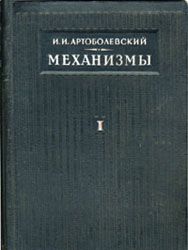 Artobolevsky I.I. Mechanisms. A Manual for Engineers, Designers, Inventors.
Artobolevsky I.I. Mechanisms. A Manual for Engineers, Designers, Inventors.Publishing house of the USSR Academy of Sciences.
The 1st edition in 4 volumes (1947, 1948, 1949, 1951). Circulation of 10 thousand copies.
The most complete classification of mechanisms is given according to their structure, kinematic possibilities and application. In a single style, schemes (models) of several thousand mechanisms are presented. Practically for each scheme, specific examples of the parameters and characteristics necessary to create real devices are given.
2nd edition "Mechanisms in Modern Technology", Publishing House "Science" in 7 volumes (1970, 1971, 1973, 1974, 1976, 6-7 volume published in 1981).
The 2nd edition was finalized and published with the assistance of the Department's research staff. The most significant contribution was made by Ph.D. N.V. Speransky and Prof., Sc. D. E.V. Hertz.
 Academician Nikolai Grigorievich Bruevich (1896 - 1987)
Academician Nikolai Grigorievich Bruevich (1896 - 1987)Main Research Trends of the Academician's Work:
- Aircraft Engines' Balancing - 1933.
- Kinetics & Statics of Flat Mechanisms - 1935
- Application of Vector Equations in the Kinematics of Plane Mechanisms - 1935
- Kinetics & Statics of Spatial Mechanisms - 1937
- Spatial Mechanisms with Passive Links - 1937.
- Mechanisms for Solving Algebraic Equations and Integration of Ordinary Differential Equations (Mechanisms for Performing Mathematical Operations) - 1941.
- Fundamentals of the Theory of Counting-Solving Devices - 1964.
- Essential Issues of Automation of Mental Work in Mechanical Engineering - 1966
- Reliability and Accuracy of Automatic Production - 1970.
- Automation of Technological Design - 1980.
His research work record at the IMASH - since 1951, namely at:
- Precise Mechanics Department (1951 – 1964),
- Intellectual Labor Automation Dept. (1964 – 1970),
- “Calculation Techniques Applied to Digital Computers" Laboratory (1970- 1987).

Bruevich N.G. Accuracy of Mechanisms. - M. - L. 1946
For the first time, a transition was made from the study of ideal mechanisms to real ones. The definitions of the primary error, positional errors and the displacement of the master and slave links, mean and limit values of errors. As the primary errors, gaps in hinges and forward pairs, inaccuracies in the dimensions of the links and the surface of the cam, misalignment of the axes, etc. are considered. The analysis of positional errors of the most important mechanisms (plane lever and gear, cam, and bevel gears) is carried out. The main method of investigation is the construction of a transformed mechanism. (The abstract was prepared by Prof. Sc.D. (Engn.) B.I.Pavlov)
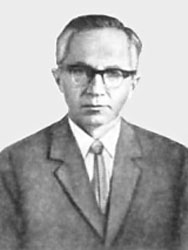
Prof., Sc. D. (Eng.) Sergey Alexandrovich Cherkudinov
In 1945, he moved to work at IMAS from the Leningrad Polytechnic Institute. Participated in writing the fundamental work "Synthesis of Plane Mechanisms" (1959). Together with Prof. N.V. Speransky published a number of works on the synthesis of flat hinged mechanisms with stops, schemes of Maltese mechanisms,
His research work has been devoted to precise and approximate methods of synthesizing the hinged transmission mechanisms.

Prof., Sc. D. (Eng.) Nikolai Ivanovich Levitsky
Since 1944 he began to cooperate with the IMASH. First he actively participated in the Workshop on the Theory of Mechanisms and Machines, led by I.I.Artobolevsky, fruitfully worked as a reviewer and Deputy Chairman of the Editorial Board of the periodical edition of the USSR Academy of Sciences, "Mechanics of Machines" Journal. Together with IIArtobolevsky, he published a report on the creative research work of
Workshop on the Theory of Mechanisms and Machines, led by I.I.Artobolevsky, fruitfully worked as a reviewer and Deputy Chairman of the Editorial Board of the periodical edition of the USSR Academy of Sciences, "Mechanics of Machines" Journal. Together with IIArtobolevsky, he published a report on the creative research work of
 Workshop on the Theory of Mechanisms and Machines, led by I.I.Artobolevsky, fruitfully worked as a reviewer and Deputy Chairman of the Editorial Board of the periodical edition of the USSR Academy of Sciences, "Mechanics of Machines" Journal. Together with IIArtobolevsky, he published a report on the creative research work of
Workshop on the Theory of Mechanisms and Machines, led by I.I.Artobolevsky, fruitfully worked as a reviewer and Deputy Chairman of the Editorial Board of the periodical edition of the USSR Academy of Sciences, "Mechanics of Machines" Journal. Together with IIArtobolevsky, he published a report on the creative research work of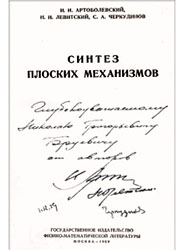 P.L. Chebyshev (1947). Participated in writing the fundamental work "Synthesis of Plane
P.L. Chebyshev (1947). Participated in writing the fundamental work "Synthesis of Plane Mechanisms." The main creation of N.I. Levitsky was a set of textbooks and teaching aids on the Theory of Mechanisms characterized by a high scientific level, intended for students and university Professors (including for physical and mathematical specialties). N.I. Levitsky developed a system of terms on the Theory of Mechanisms.

Prof., Sc. D. (Eng.) Yevgeny G. Nakhapetyan (1922 - 2009)
Since 1952 - an employee of IMASH RAN. He headed the laboratories of
Experimental Dynamics of Machines and of Diagnostics of Machines; as well as he headed this Department of Machines Mechanics and Machines Control.
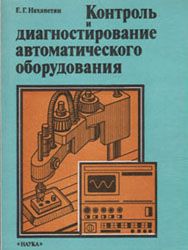 Nakhapetyan Ye.G. Automatic Equipment Control and Diagnostics. M .: Science. 272 pp., 1990.
Nakhapetyan Ye.G. Automatic Equipment Control and Diagnostics. M .: Science. 272 pp., 1990.Various aspects of the application of comprehensive methods for the experimental determination of kinematic and dynamic parameters, mathematical methods for simulation, quality assessment, testing, diagnostics: automatic lines, GPS, robots, CNC machines and other automatic equipment are considered. Unified test methods, test strategy, computerized test systems, sensors, methods for determining the quality criteria of mechanisms are presented.
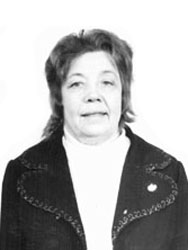 Prof., Sc. D. (Eng.) Elena Vasilievna Gerts (1914 - 2004)
Prof., Sc. D. (Eng.) Elena Vasilievna Gerts (1914 - 2004)In 1943 E.V. Hertz entered the Mechanical Engineering Research Institute of the USSR Academy of Sciences as a Junior Research Fellow of the Department of the Theory of Machines and Mechanisms, which was headed by her teacher at MIKHM, Academician I.I. Artobolevsky.
The first scientific results of Elena Vasilievna related to the systematization, research and calculation of mechanisms with hydraulic links, which later became a part of the multivolume handbook on mechanisms edited by Academician Ivan I. Artobolevsky.
In 1954, Elena Vasilievna defended her Ph.D. thesis, dedicated to the classification and calculation of pneumomechanical devices. In 1966, she defended her doctoral dissertation on the topic "Dynamics and synthesis of pneumatic systems of machines," thereby laying the foundation for a new direction in the theory of mechanisms and machines.
Along with scientific work, Elena Vasilievna taught the Theory of Mechanisms and Machines at the Moscow Aviation Institute and the All-Union Correspondence Polytechnic Institute (1957-1960) and worked with Ph. D. students. Under her leadership and participation, work was done on the calculation of new types of high-speed, positional and rotary pneumatic drives, a theory of pneumatic systems with distributed parameters was created. Under her scientific supervision there have been successfully defended 15 Ph. D. thesises and 2 Sc. D. works.
In 1973, Elena V. organized a subsequently popular periodic collection of scientific articles "Pneumatics and Hydraulics" and was his permanent responsible Editor. The scientific and technical community of the country owes it to her the founding the All-Union Workshop on "Pneumatics and Hydraulics", which enjoyed wide popularity and authority in the 80s and 90s of the 20th century.
 Prof. Elena Vasilievna Hertz is the author of more than 170 articles and 8 monographs, including "Pneumatic Drives" (Moscow: "Machine Building", 1969) and "Dynamics of Pneumatic Machine Systems" (Moscow: "Mashinostroenie", 1985), and also written in co-authorship with G.V. Kreinin "Theory and Calculation of Power Pneumatic Devices" (Moscow: Izd-vo AN SSSR, 1960) and "Dynamics of Pneumatic Drives of Automatic Machines" (Moscow: Mashinostroenie, 1964). The first monograph has been translated and repeatedly published abroad.
Prof. Elena Vasilievna Hertz is the author of more than 170 articles and 8 monographs, including "Pneumatic Drives" (Moscow: "Machine Building", 1969) and "Dynamics of Pneumatic Machine Systems" (Moscow: "Mashinostroenie", 1985), and also written in co-authorship with G.V. Kreinin "Theory and Calculation of Power Pneumatic Devices" (Moscow: Izd-vo AN SSSR, 1960) and "Dynamics of Pneumatic Drives of Automatic Machines" (Moscow: Mashinostroenie, 1964). The first monograph has been translated and repeatedly published abroad.Based on the scientific work of E.V. Hertz in many higher technical institutions of the country there have been created and read lecture courses on the Theory of Pneumatic Systems as a section of TMM (Theory of Machines and Mechanisms).
Hertz E.V. Dynamics of Pneumatic Systems of Machines. М .: Mechanical engineering. 1985.
The problems of dynamics of pneumatic systems of drives, representing a set of executive, distributive and control devices are investigated. Methods are given for calculating the typical drives of the translational and rotational motion, allowing to determine the time of their operation or, at a given time of the working cycle, to choose rational parameters. The methods of dynamic calculation and schemes with the optimal structure of high-speed pneumatic drives are proposed with the aim of obtaining the high speeds (an order of magnitude higher than for typical ones) with minimum dimensions and weight.
